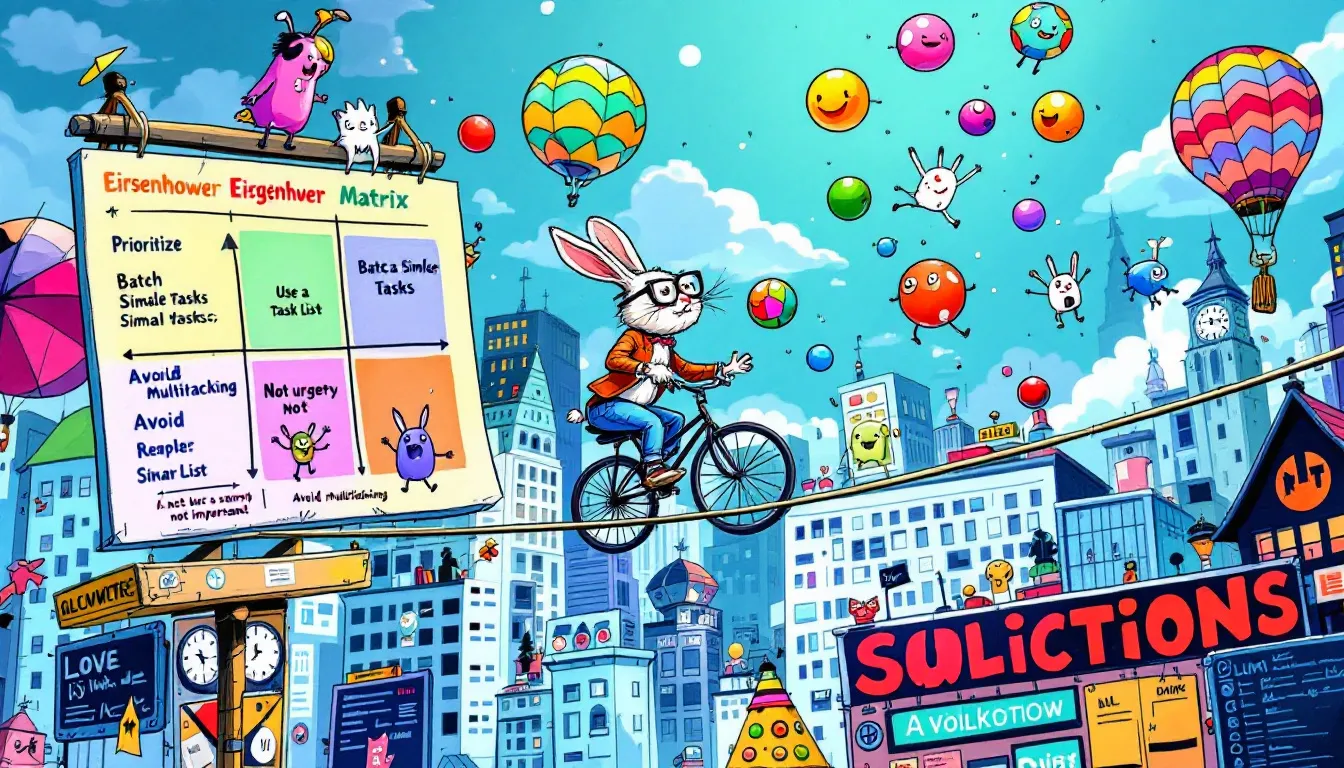Switching Tasks: The Hidden Costs and Practical Solutions
Switching tasks refers to moving focus between two or more activities. This common practice is often mistaken for multitasking, but it disrupts our concentration and productivity. Frequent task switching can make it hard to achieve deep work and maintain concentration. In this article, we will explore the hidden costs of task switching and provide practical solutions to manage it effectively.
Key Takeaways
- Task switching disrupts focus and reduces productivity significantly, characterized by slower performance speed and higher cognitive load.
- The hidden costs of task switching include time loss, increased cognitive demands, and emotional strain, which can lead to lower job satisfaction.
- Practical solutions such as automation, time blocking, and single-tasking can effectively minimize task switching and enhance overall productivity.
Understanding Task Switching

Task switching refers to the process of moving focus between multiple tasks, including two or more tasks. It is often mistaken for multitasking, which involves handling multiple tasks simultaneously or switching tasks rapidly. While multitasking may seem efficient, a task switch inherently disrupts focus and performance, making it harder to achieve deeper work and maintain concentration. We often find ourselves context switching during the day, from responding to texts during phone calls to checking emails while in meetings. These frequent switches scatter our attention and interrupt our workflow.
The cognitive process behind task switching involves two main stages: goal shifting and rule activation. Goal shifting refers to deciding to switch tasks, while rule activation involves adjusting the mental control settings required for the new task. This process incurs cognitive costs as individuals must suppress the previous task set to focus on the next one, leading to what is known as task set inertia. The lingering cognitive effects from the last task, known as attention shifting residue, can cloud concentration and make it harder to perform the new task effectively.
Research indicates that task switching is characterized by slower performance speed and lower accuracy, impacting overall effectiveness. Knowledge workers, for example, switch between applications 10 to 25 times a day, reflecting the prevalence of task switching in modern work environments.
Understanding the mechanics and implications of task switching is crucial for developing strategies to minimize its negative impact on our productivity and mental well-being.
The Hidden Costs of Task Switching (And the Systems That Eliminate It)

Task switching comes with a plethora of hidden costs that can significantly reduce productivity. Frequent switching scatters focus, leading to more mistakes and time loss. The cumulative time loss from task switching can be staggering, with up to 40% of productive time being lost. This is particularly detrimental in high-stakes environments, where even minor time losses can have significant impacts.
The hidden costs of task switching can be categorized into three main areas: time costs, cognitive load, and emotional strain. Understanding these costs is the first step in developing systems to eliminate them.
Automation tools, for example, can reduce tedious tasks and prevent task switching, boosting overall productivity. Addressing these hidden costs can help create a more efficient and focused work environment.
Time Costs
Time is one of the most significant costs of task switching. Each switch requires mental readjustments, leading to time loss and reduced efficiency. Complex tasks incur higher switching costs, resulting in even more time lost when transitioning between them. In a busy work environment, even minor time losses from switching tasks can accumulate, significantly impacting overall productivity. The concept of switching cost is crucial in understanding these dynamics.
The time cost associated with task switching involves adjusting mental control settings and managing competing cognitive demands. For example, salespeople frequently experience increased cognitive load due to the constant need to switch tasks, leading to a cumulative time loss that affects their productivity.
Minimizing these costs requires effective time management strategies to maintain a high level of task performance.
Cognitive Load
Task switching increases cognitive demands, resulting in mental fatigue and diminished performance. When we frequently switch tasks, our working memory is constantly taxed, leading to decreased efficiency and more errors. Cognitive processes such as executive control and cognitive flexibility are heavily involved in task switching, making it a mentally exhausting activity.
Managing cognitive load effectively can enhance overall task performance and reduce mental fatigue. Techniques like the Pomodoro Technique, which encourages breaks, can be effective in reducing mental fatigue and maintaining cognitive health.
Recognizing how cognitive load impacts performance is crucial for developing strategies to minimize task switching and boost productivity through simple cognitive tasks, including cognitive control.
Emotional Strain
Constantly shifting tasks can elevate emotional stress and lead to feelings of frustration and reduced job satisfaction. This emotional strain is similar to the mental overload experienced in high-precision scenarios like air-traffic control. The psychological review of the toll of frequent task switching can lead to burnout and decreased overall well-being.
Addressing the emotional strain caused by task switching involves understanding the environmental demands and managing cognitive load effectively. Creating a work environment that minimizes distractions and encourages focused work can help reduce emotional stress and improve job satisfaction.
The Neuroscience Behind Multitasking

The human cognitive system is not naturally equipped for heavy multitasking, leading to mental overload and decreased productivity. Many believe that multitasking is effective and improves productivity, but studies indicate this is a misconception. Our brain’s working memory is optimized when focusing on a single task rather than engaging in multitasking, which is influenced by human perception.
Task switching significantly reduces productivity by increasing time costs and cognitive load. Understanding the neuroscience of multitasking can inform design improvements in high-stakes environments, like aviation and traffic management. Future studies should assess the role of stimulus-response compatibility in the task switching paradigm and task switching experiments to understand its effects on performance.
Exploring the impact of task switching on dual-task performance in naturalistic settings can enhance ecological validity in research, as highlighted in the journal of experimental psychology. By delving deeper into the neuroscience behind multitasking, we can develop more effective strategies to minimize task switching and improve overall productivity in experimental psychology.
Practical Solutions to Minimize Task Switching

Focusing on high-value tasks without switching can significantly improve productivity. Key points include:
- Prioritizing time management helps in avoiding the switch cost effect, leading to better performance.
- Developing strategies to reduce task switching is essential to maintaining flow and attention.
- Time blocking helps create a structured workflow, thereby reducing the incidence of task switching.
Setting clear boundaries for focused work can significantly enhance productivity by minimizing distractions. Utilizing automation tools can streamline repetitive tasks, allowing for greater focus on critical work. Implementing these strategies collectively can lead to a more productive work environment.
Automation Tools
Automation significantly reduces task switching by handling routine tasks. By automating repetitive tasks, workers can focus on more complex challenges that require cognitive resources. Using integrations among tools can streamline work processes and minimize task switching.
Overall, leveraging automation and tool integration leads to increased productivity and reduced stress levels. For example, automating email sorting or scheduling can free up mental bandwidth for more strategic tasks, thereby enhancing overall task performance.
Task Batching
Task batching involves grouping similar tasks together and working on them in blocks. This approach minimizes the cognitive load associated with switching between different tasks and helps maintain focus. Creating coworking sessions, whether virtual or in-person, can help reduce distractions and enhance productivity, especially when using task sets.
Breaking down larger projects into smaller tasks aids in minimizing overwhelm and maintaining focus. By dedicating specific time blocks to similar tasks, individuals can reduce task switching and improve overall efficiency while managing a different task or new tasks.
Deep Work Sessions
Participants felt 43% more productive when avoiding task switching during work sessions. Deep work allows you to concentrate on a specific task. This minimizes task switching, enhances performance, and reduces switching costs. Reducing distractions is key to creating an environment conducive to deep work.
Turning on do-not-disturb mode minimizes switch costs from digital notifications on cell phones. Clarifying task importance helps maintain focus during periods of deep work. Uninterrupted focus is crucial for peak task performance during deep work sessions.
Implementing Single-Tasking Strategies

Single-tasking is focusing all cognitive processes on a single task until completion or a stopping point. This approach significantly enhances concentration and attention to detail, often leading to higher quality outcomes due to undivided attention. Timeboxing is a technique that involves committing full attention to a task by assigning a fixed time block.
Single-tasking strategies can reduce task switching and improve overall productivity. By focusing on one task at a time, individuals can feel productive and achieve a flow state, where they are fully immersed in their work and performing at their best.
Time Blocking
Time blocking involves scheduling specific time slots for tasks. This technique helps to structure work sessions, leading to improved focus. Assigning specific time slots to tasks minimizes the likelihood of distractions.
The chunking method, which involves grouping similar tasks, is effective for maintaining focus. By dedicating uninterrupted time blocks to specific tasks, individuals can reduce task switching and enhance overall productivity, allowing them to complete tasks in rapid succession.
Pomodoro Technique
The Pomodoro Technique is a time management method involving 25 minutes of focused work followed by 5-minute breaks. This technique helps maintain high levels of concentration and reduces the mental fatigue associated with task switching.
The work period in the Pomodoro Technique is 25 minutes long, followed by a 5-minute break. By minimizing task switching during these focused work periods, individuals can improve their overall productivity and manage their time more effectively.
Prioritizing Tasks
Prioritizing tasks helps individuals focus on what is most important, increasing overall efficiency. Known as the Pareto Principle, it suggests that 80% of results come from 20% of efforts. By prioritizing the most important tasks, one can reduce task switching and enhance productivity.
Ranking two tasks by importance minimizes distractions and reduces the urge to switch tasks. Breaking down big projects into smaller tasks and prioritizing the next task can help individuals maintain focus and achieve their goals more effectively.
Future Research Directions
Research shows that psychological research on task switching costs is critical for enhancing efficiency in multitasking environments. Understanding the brain’s reorganization process during task switching and its basic mechanisms can provide insights into minimizing associated costs. A significant challenge in research concerning task-set priming involves differentiating between active and passive processes.
Executive control processes involved in task switching consist of ‘goal shifting’ and ‘rule activation,’ both crucial for task management. Future studies should explore these processes further to develop more effective strategies for minimizing task switching and improving productivity.
Summary
In conclusion, task switching imposes hidden costs on productivity, cognitive load, and emotional well-being. Understanding the neuroscience behind multitasking and implementing practical solutions like automation tools, task batching, and deep work sessions can help minimize these costs. By adopting single-tasking strategies and prioritizing tasks, individuals can enhance their focus and achieve better outcomes. Embracing these practices will lead to a more productive and fulfilling work life.

Frequently Asked Questions
What is task switching?
Task switching is the process of shifting attention from one task to another, which can hinder concentration and diminish overall performance.
How does task switching affect productivity?
Task switching negatively impacts productivity by potentially causing a loss of up to 40% of productive time because of the necessary mental adjustments and cognitive costs. Minimizing task switching can help enhance overall efficiency and focus.
What are some practical solutions to minimize task switching?
To minimize task switching effectively, implement automation tools, batch similar tasks together, and dedicate focused sessions for deep work. These strategies significantly enhance productivity.
How does the Pomodoro Technique help with task switching?
The Pomodoro Technique aids in task switching by promoting sustained focus during 25-minute work intervals, which minimizes mental fatigue and enhances productivity. This structured approach allows for efficient breaks that refresh your mind before tackling new tasks.
Why is it important to prioritize tasks?
It is crucial to prioritize tasks to enhance focus on what truly matters, thereby boosting efficiency and productivity. Effective prioritization minimizes distractions and maximizes the use of your time.
